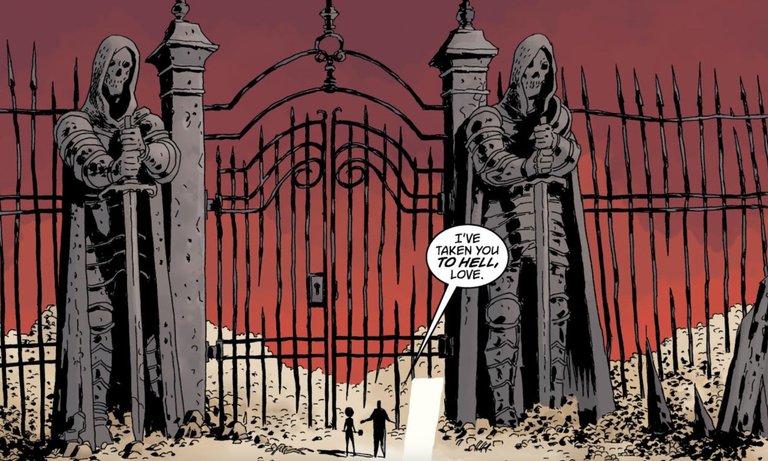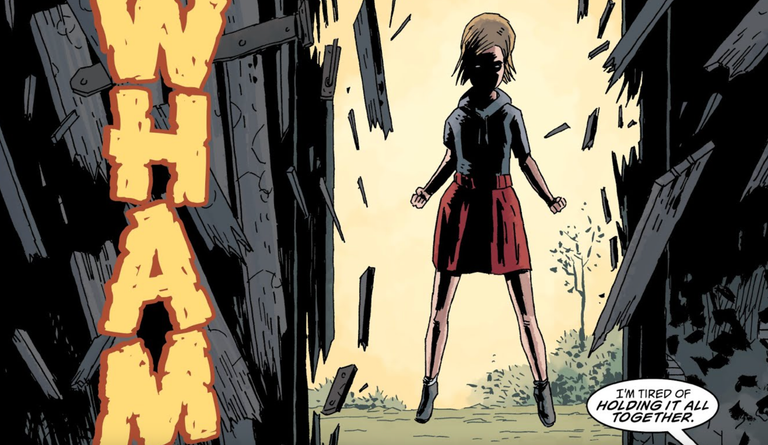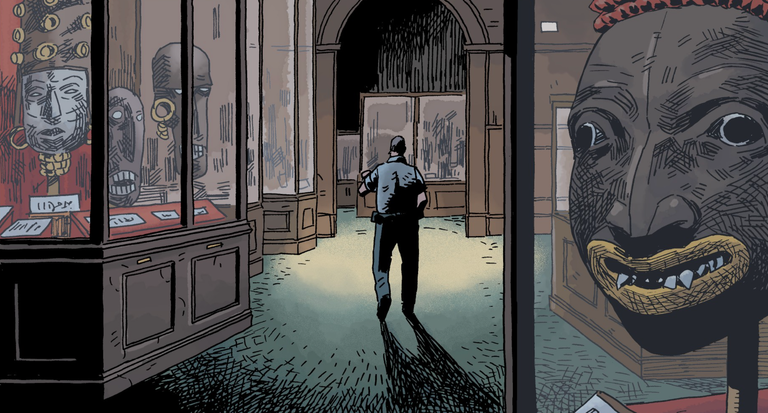
Over the past week I have been reading a Dark Horse comic series called Black Hammer. I didn't know anything about it prior to reading it, and I'm certainly a few years late to the party. I reviewed the first edition of its 13 initial volumes the other day, to which I detailed the things I enjoyed about its characters and general premise of heroes being swept away into a strange realm in which nothing makes sense. I enjoyed how diverse the development of its characters was as some enjoyed this state of purgatory as it implied a finally stable lifestyle to them after a life of fighting strange entities and crime to maintain stability in a city. There were a lot of interesting ideas which came and went within the first 13 volumes that had me left with a plethora of questions that went unanswered, though I wasn't too happy about that given how long and dragged-out that narrative started to feel. It was clear that these first 13 volumes were made to introduce the characters and main problem to the audience, and to no surprise there would be follow-up stories that would carry on from that point and start to push that narrative forward with a bit more context. Now, context is the main thing I wanted from the story, after all it kept teasing these oddities within the strange world that the characters found themselves within.
With so much exposition and hints that led nowhere, I felt a bit frustrated with finished the first comic. I wanted to know more, and it was more out of an annoyance of how much time I had invested into reading through it without being told much. I can't say I enjoyed this aspect of it, but it was enough for me to bite down and find the next follow-up of its story, to which that would be Black Hammer: Age of Doom. The story picks up immediately after the events of the 13th volume, which was a nice surprise to see, given it did instantly give off that feeling that the ending wasn't just going to go nowhere, but would continue on. It was too much of a cliffhanger for me to be satisfied, essentially. And with Age of Doom, things certainly picked up and grew a little more strange from the first volume, revealing a bit more to the universe. We saw a glimpse of this in the first edition to which one character is in a constant state of trauma, and seems to have the ability to navigate through time and space, seeing all the terrors of various worlds and dimensions, outcomes of the past, present, and future. Though cryptic and void of direction, his ramblings offer little more than, again, hints at something more to come. Often perceived as the ramblings of a crazy old man that barely makes any sense.
Character introductions were the focus of the previous volumes, and it briefly opened the door to some of their more human elements, even if some aren't quite so human anymore (or ever were in the first place). And I was curious as to whether it would be taken to new heights with Age of Doom.

In my last review of the first 13 volumes, I mentioned that I enjoyed the premise of a group of characters being stuck in some strange realm to which they can't escape. And how some had managed to find peace in that realm, whether it was true or not. I also mentioned a few problems with those first volumes, and how it felt like a lot of exposition rather than giving us any actual answers as to what was going on. From the start, this next addition to the Black Hammer universe changes everything, diving into the narrative from the start, totally picking up and giving us the answers to all of those questions that were had. Though some of those answers are a little underwhelming, I enjoyed that it didn't continue to carry on with exposition. After all, those first 13 volumes were absolutely nothing more than an introduction tot he universe and its characters, being relatively tame in what it told to us, ensuring not a lot was explained, rather establishing everything to set up the following publications. I expected this, though I can't say I enjoyed it all that much. I do think I have been enjoying this sequel a lot more given how much faster it feels, to some degree it maintained some of that established narrative and led us down a few paths, but it was quick to push itself beyond the farm setting and give us some context.
One thing I didn't like was how much it setup the emotional side of the characters that did enjoy being in that realm, how they had found something to live for there, while the rest were more interested in escaping. Once they did escape it, all of that interest they had was short-lived, it didn't lead to much more trauma and drama, things picked up incredibly fast from that point. And I think it's this faster pacing that allows for the volumes to hold your attention, this movement picks up and continues, constantly revealing new things and having the characters roaming through different environments, giving us context as to what this space that they're stuck within really is, and why they're there in the first place. The first volume told us of a great battle to which both the enemy and the heroes ended up destroyed in, though they woke up in a new space that seemed like purgatory. To some degree that is what it was, though created by one of their own under the assumption of balance. For a great evil to remain at bay, the good needed to also leave. To which they were taken and placed into deep space in another realm, entering a sleep that threw them into an alternate reality. I liked that some of the characters wanted to return upon waking up, not caring for the reality, as their false reality actually had more to offer them. Though that engagement was relatively thin due to that faster pacing, not allowing for time to take in the new changes.
It's with these changes that some of the volumes feature a change in art style, to which I didn't quite enjoy. But I understood the appeal of it, to change the art style with the worlds some of the characters now find themselves in, how unique they are to the rest. As if to visually signify the changes that they now face. This does make individual stories stand out more, but I didn't really like how the style itself was. It does make you forget about the main story a bit as we follow these other characters, and giving individual characters their own side stories is also effective in giving us more reasons to care for them and understand their importance in the grand scheme of things, each event still contributing to the main narrative in one way or another. These stories disconnect us a little from that main narrative and give that side of things more pacing, a sort of unexpected transition into another form of exposition, but I do think it works a bit better than previous volumes which definitely focused too much on back-stories. Some of the environments the characters end up in are interesting, it hints at a type of universe in which there are windows and doors into other worlds, each with odd realms that often look incredibly hellish. Odd zombie-like beings roam through them. There is even a world in which heroes with unfinished stories attend. It makes you question what that side of things is all for, and while other questions go answered, this leads to new ones that keeps the story interesting.

One thing I don't like though, it seems to be setting up some idea of a multiverse. A group of universes that are connected through various stories and heroes. How each of these worlds are connected. I think I'm just a little tired of the whole multiverse thing, but I think this was coming out around the time that the whole idea of such things wasn't already exhausted. But now it feels a bit dated and honestly a little lazy. A little bit of a tired feeling was felt when it focused on this side of things for a while. In many cases it shows a multiverse in which many heroes had failed somehow, and how their realities had shifted with events that just were not meant to turn out the ways in which they did. Superheroes that don't quite succeed, and what happens as a result of this.
Quite interesting and good article.